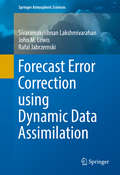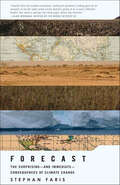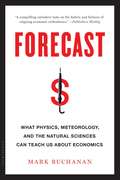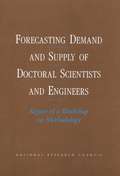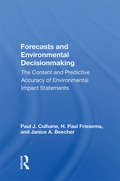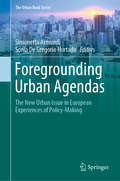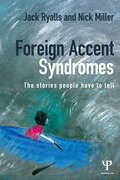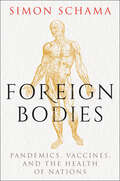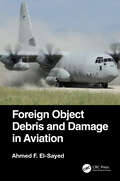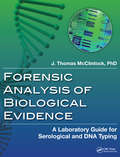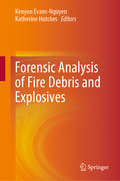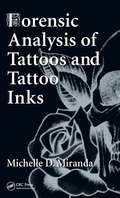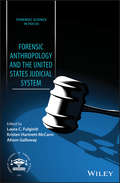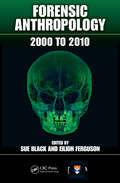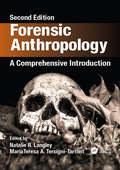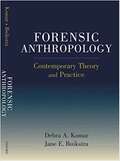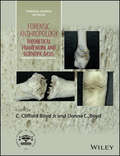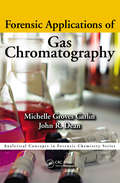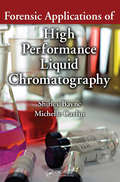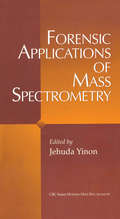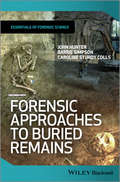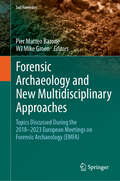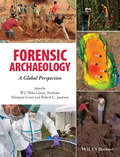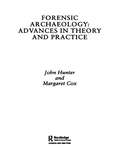- Table View
- List View
Forecast Error Correction using Dynamic Data Assimilation
by Sivaramakrishnan Lakshmivarahan John M. Lewis Rafal JabrzemskiThis book introduces the reader to a new method of data assimilation with deterministic constraints (exact satisfaction of dynamic constraints)--an optimal assimilation strategy called Forecast Sensitivity Method (FSM), as an alternative to the well-known four-dimensional variational (4D-Var) data assimilation method. 4D-Var works with a forward in time prediction model and a backward in time tangent linear model (TLM). The equivalence of data assimilation via 4D-Var and FSM is proven and problems using low-order dynamics clarify the process of data assimilation by the two methods. The problem of return flow over the Gulf of Mexico that includes upper-air observations and realistic dynamical constraints gives the reader a good idea of how the FSM can be implemented in a real-world situation.
Forecast: The Surprising—and Immediate—Consequences of Climate Change
by Stephan FarisA vivid and illuminating portrayal of the surprising ways that climate change will affect the world in the near future—politically, economically, and culturallyWhile reporting just outside of Darfur, Stephan Faris discovered that climate change was at the root of that conflict, and began to wonder what current and impending—and largely unanticipated—crises such changes have in store for the world. Forecast provides the answers.Global warming will spur the spread of many diseases. Italy has already experienced its first climate-change epidemic of a tropical disease, and malaria is gaining ground in Africa. The warming world will shift huge populations and potentially redraw political alliances around the globe, driving environmentalists into the hands of anti-immigrant groups. America's coasts are already more difficult places to live as increasing insurance rates make the Gulf Coast and other gorgeous spots prohibitively expensive. Crops will fail in previously lush places and thrive in some formerly barren zones, altering huge industries and remaking traditions. Water scarcity in India and Pakistan have the potential to inflame the conflict in Kashmir to unprecedented levels and draw the United States into the troubles there, and elsewhere.Told through the narratives of current, past, and future events, the result of astonishingly wide travel and reporting, Forecast is a powerful, gracefully written, eye-opening account of this most urgent issue and how it has altered and will alter our world.
Forecast: What Physics, Meteorology, And The Natural Sciences Can Teach Us About Economics
by Mark BuchananPositive feedback--when A produces B, which in turn produces even more A--drives not only abrupt climate changes, but also the most important and disruptive events in economics and finance, from asset bubbles to debt crises, bank runs, even corporate corruption. But economists, with few exceptions, have ignored this reality for fifty years, holding onto the unreasonable belief in the wisdom of the market. It's past time to be asking how do markets really work? Can we replace economic magical thinking with a better means of predicting what the financial future holds, in order to prepare for, or even avoid the next extreme economic event? <P> In Forecast, physicist and acclaimed science writer Mark Buchanan answers these questions and more in building a new model for economics, one that accepts that markets act much like the weather does. While centuries of classical financial thought has trained us to understand "the market" as something that always returns to equilibrium, economies work more like our atmosphere--a loose surface balance riding on a deeper torrent of fluctuation. Market instability is as natural--and dangerous--as a prairie twister. With Buchanan's help, we can better govern the markets and weather their storms.
Forecasting Demand and Supply of Doctoral Scientists and Engineers: Report of a Workshop on Methodology
by Office of Scientific Engineering PersonnelThis report is the summary of a workshop conducted by the National Research Council in order to learn from both forecast makers and forecast users about improvements that can be made in understanding the markets for doctoral scientists and engineers. The workshop commissioned papers examined (1) the history and problems with models of demand and supply for scientists and engineers, (2) objectives and approaches to forecasting models, (3) margins of adjustment that have been neglected in models, especially substitution and quality, (4) the presentation of uncertainty, and (5) whether these forecasts of supply and demand are worthwhile, given all their shortcomings. The focus of the report was to provide guidance to the NSF and to scholars in this area on how models and the forecasts derived from them might be improved, and what role NSF should play in their improvement. In addition, the report examined issues of reporting forecasts to policymakers.
Forecasts And Environmental Decision Making: The Content And Predictive Accuracy Of Environmental Impact Statements
by Paul J. CulhaneThis book evaluates the predictive accuracy of the forecasts in a sample of federal environmental impact statements. It examines a major federal attempt to impose rationalistic reforms on government decision makers and the first view of National Environmental Policy Act reforms.
Foregrounding Urban Agendas: The New Urban Issue in European Experiences of Policy-Making (The Urban Book Series)
by Simonetta Armondi Sonia De Gregorio HurtadoThis book highlights the discontinuities and the ongoing development of the urban question in policy-making in the context of the controversial current issues of global reversal and regional revival. It critically examines contemporary public policies and practices at the urban, regional and national scales in order to offer a timely contribution to the debate on the significance of the urban dimension and interpretation in terms of the theory, policy and practice of social-spatial research in the twenty-first century. Focusing on Europe, it explores the current urban policy agendas at different scales - and the mobility of those agendas -, their implications, contradictions and controversies. It brings together original contributions from multiple disciplines but with an urban perspective, including empirical case studies and critical discussions of the following topics:the UN 2030 Agenda for Sustainable Development, the global “New Urban Agenda” as part of the Habitat III process;the Urban Agenda for the European Union;national spatial policies related to urban agendas;urban agendas at regional/urban levels;city regionalism discourse and state rescaling;new formal regional and metropolitan governments as a solution (or problem);the role of new actors in regional urbanization dynamics; multi-level governance processes in developing an urban agenda; informal assemblages at the metropolitan scale aiming at constructing the urban concept and dimension.Given its scope, the book is of interest to urban, regional and EU policy-makers, scholars and students working in the fields of urban geography, urban studies, EU urban and regional policies, and planning.
Foreign Accent Syndromes: The stories people have to tell
by Nick Miller Jack RyallsWhat does it feel like to wake up one day speaking with a foreign accent from a country one has never visited? Why does someone wake up doing this? This book seeks to portray the broad and diverse experiences of individuals with a rare neurological speech disorder called Foreign Accent Syndrome (FAS). Through a combination of personal testimony and scientific commentary, the book aims to shed unprecedented light on the understanding of FAS by elucidating the complex links between how the brain produces speech, how listeners perceive speech and the role that accent plays in our perception of self and others. The first part of the book provides a comprehensive introduction to FAS and covers a number of key subject areas, including: • The definition and phenomenology of FAS • A history of research on FAS • The causes and psychosocial consequences of FAS • A guide to further reading and a glossary of specialized terms. The chapters in part two provide a unique insight into the condition through personal testimony and accounts from family members. This collection of 28 testimonies from across the world underlines the importance of listening carefully to patients explain their cases, and in their own words. The final section contains a questionnaire for use by clinicians to support case history taking. The authors are two leading global experts on FAS, and this is the first volume of its kind to provide such a broad and comprehensive examination of this rare and poorly understood condition. It will be of great interest to practising clinicians in neurology, psychiatry, psychology and speech and language therapy/pathology, as well as students in health disciplines relevant to neurorehabilitation, linguists and also to families and caregivers.
Foreign Bodies: Pandemics, Vaccines, and the Health of Nations
by Simon SchamaA vibrant cultural history investigating the tangled and complex history of pandemics and vaccines, by bestselling author and historian Simon SchamaCities and countries engulfed by panic and death, desperate for vaccines but fearful of what inoculation may bring. This is what the world has just gone through with Covid-19. But as Simon Schama shows in his epic history of vulnerable humanity caught between the terror of contagion and the ingenuity of science, it has happened before. Characteristically, Schama’s message is delivered through gripping, page-turning stories set in the eighteenth and nineteenth centuries: smallpox strikes London; cholera hits Paris; plague comes to India. Threading through the scenes of terror, suffering and hope – in hospitals and prisons, palaces, and slums – are an unforgettable cast of characters: a philosopher-playwright burning up with smallpox in a country chateau; a vaccinating doctor paying house calls in Halifax; a woman doctor in south India driving her inoculator-carriage through the stricken streets as dead monkeys drop from the trees. But we are also in the labs when great, life-saving breakthroughs happen, in Paris, Hong Kong, and Mumbai. At the heart of it all is an unsung hero: Waldemar Haffkine, a gun-toting Jewish student in Odesa turned microbiologist at the Pasteur Institute, hailed in England as “the saviour of mankind” for vaccinating millions against cholera and bubonic plague in British India while being cold-shouldered by the medical establishment of the Raj. Creator of the world’s first mass production line of vaccines in Mumbai, he is tragically brought down in an act of shocking injustice. Foreign Bodies crosses borders between east and west, Asia and Europe, the worlds of rich and poor, politics and science. Its thrilling story carries with it the credo of its author on the interconnectedness of humanity and nature; of the powerful and the people. Ultimately, Schama says, as we face the challenges of our times together, “there are no foreigners, only familiars.”
Foreign Object Debris and Damage in Aviation
by Ahmed F. El-SayedForeign Object Debris and Damage in Aviation discusses both biological and non-biological Foreign Object Debris (FOD) and associated Foreign Object Damage (FOD) in aviation. The book provides a comprehensive treatment of the wide spectrum of FOD with numerous cost, management, and wildlife considerations. Management control for the debris begins at the aircraft design phase, and the book includes numerical analyses for estimating damage caused by strikes. The book explores aircraft operation in adverse weather conditions and inanimate FOD management programs for airports, airlines, airframe, and engine manufacturers. It focuses on the sources of FOD, the categories of damage caused by FOD, and both the direct and indirect costs caused by FOD. In addition, the book provides management plans for wildlife, including positive and passive methods. The book will interest aviation industry personnel, aircraft transport and ground operators, aircraft pilots, and aerospace or aviation engineers. Readers will learn to manage FOD to guarantee air traffic safety with minimum costs to airlines and airports.
Forensic Analysis of Biological Evidence: A Laboratory Guide for Serological and DNA Typing
by J. Thomas McClintockA powerful tool in the identification of individuals, DNA typing has revolutionized criminal and paternity investigations. Widespread analysis is now conducted by public and private laboratories in the United States and abroad. Focusing on the basic techniques used in forensic DNA laboratories, Forensic Analysis of Biological Evidence: A Laboratory
Forensic Analysis of Fire Debris and Explosives
by Kenyon Evans-Nguyen Katherine HutchesThis text provides training on the fundamental tools and methodologies used in active forensic laboratories for the complicated analysis of fire debris and explosives evidence. It is intended to serve as a gateway for students and transitioning forensic science or chemistry professionals. The book is divided between the two disciplines of fire debris and explosives, with a final pair of chapters devoted to the interplay between the two disciplines and with other disciplines, such as DNA and fingerprint analysis. It brings together a multi-national group of technical experts, ranging from academic researchers to active practitioners, including members of some of the premier forensic agencies of the world. Readers will gain knowledge of practical methods of analysis and will develop a strong foundation for laboratory work in forensic chemistry. End-of-chapter questions based on relevant topics and real-world data provide a realistic arena for learners to test newly-acquired techniques.
Forensic Analysis of Tattoos and Tattoo Inks
by Michelle D. MirandaForensic Analysis of Tattoos and Tattoo Inks is the single most comprehensive resource on the analysis of tattoo inks and use of tattoos as a tool in forensic investigations and criminalistics. The book begins with a history of tattoos and tattoo inks, and covers the use of tattoos throughout time as aids in the identification of individuals. It pr
Forensic Anthropology and the United States Judicial System (Forensic Science in Focus)
by Alison Galloway Laura C. Fulginiti Kristen Hartnett-McCannA guide to the interface between forensic anthropology and the United States legal system Designed for forensic anthropologists at all levels of expertise, Forensic Anthropology and the United States Judicial System offers a comprehensive examination of how to effectively present osteological analyses, research and interpretations in the courtroom. Written by noted experts, the book contains an historical perspective of the topic, a review of current legislation that affects expert testimony as well as vital information on courtroom procedure and judicial expectation of experts. A comprehensive book, Forensic Anthropology and the United States Judicial System explains how to prepare case reports and offers suggestions for getting ready for pre-trial interviews. The book also includes detailed information on affidavits, fee structures and dealing with opposing experts. This book is part of the popular Wiley – American Association for Forensic Sciences series and: Offers a unique volume that addresses the interface between forensic anthropology and the legal system Contains detailed guidelines for expert testimony by forensic anthropologists with all levels of experience, from beginner to expert Includes information from the perspective of the Judiciary in terms of process and expectations of the Court Shows how to maintain independence from, and collaborate with other experts Presents detailed explanations of current legislation impacting forensic science Forensic Anthropology and the United States Judicial System is an information-filled guide for practitioners of the rapidly growing field that integrates forensic sciences and the judicial system.
Forensic Anthropology: 2000 to 2010
by Sue Black Eilidh FergusonAdvances in our ability to analyse information from skeletal remains and subsequent developments in the field of forensic anthropology make it possible to identify more victims of homicides, mass-fatality disasters, and genocide. Summarizing the vast collection of international literature that has developed over the past decade, this volume explores critical themes fundamental to this evolving discipline. Topics discussed include age determination in juveniles and adults; sex, race, and ancestry determination; stature determination; dental and facial identification; skeletal trauma and bone pathology; taphonomy and comparative osteology; and identification from soft tissues.
Forensic Anthropology: A Comprehensive Introduction, Second Edition
by Natalie R. Langley MariaTeresa A. Tersigni-TarrantThis robust, dynamic, and international field has grown to include interdisciplinary research, continually improving methodology, and globalization of training. Reflecting the diverse nature of the science from experts who have shaped it, Forensic Anthropology: A Comprehensive Introduction Second Edition builds off of the success of the first edition and incorporates standard practices in addition to cutting-edge approaches in a user-friendly format, making it an ideal introductory-level text.
Forensic Anthropology: A Comprehensive Introduction, Second Edition
by Natalie R. Langley MariaTeresa A. Tersigni-TarrantThis robust, dynamic, and international field has grown to include interdisciplinary research, continually improving methodology, and globalization of training. Reflecting the diverse nature of the science from experts who have shaped it, Forensic Anthropology: A Comprehensive Introduction Second Edition builds off of the success of the first edition and incorporates standard practices in addition to cutting-edge approaches in a user-friendly format, making it an ideal introductory-level text.
Forensic Anthropology: Contemporary Theory and Practice
by Debra Komar Jane BuikstraForensic anthropology is a vastly popular and rapidly changing profession, yet to date there has been no volume that reflects the current state of the discipline and forecasts its future. <p><p> The first comprehensive text in the field, Forensic Anthropology: Contemporary Theory and Practice examines the medical, legal, ethical, and humanitarian issues associated with forensic anthropology, current forensic methods, and bio-historical investigations. <p><p> Forensic Anthropology offers a unique synthesis of theoretical and methodological coverage. Rather than simply describing methodology, Komar and Buikstra place forensic anthropology in the broader context of medico-legal death investigations, critically evaluating practical techniques in a scientific framework and detailing the anthropologist's role in relation to both law enforcement and the medical examiner or coroner. <p><p> The authors review the current state of the field, emphasizing recent changes to the judicial guidelines regarding the admissibility of scientific evidence in court. They highlight the impact of these rulings, the increased need for scientific rigor, and the evolving nature of anthropological studies, preparing students to function effectively in the demanding judicial system that will evaluate their work in the future. The text also stresses the vital importance of research in the development of forensic applications of anthropology. <p><p> Forensic Anthropology is enhanced by numerous illustrative case studies and more than ninety photos and illustrations that help to deepen and enrich students' understanding of the material. Coauthored by a top authority in forensic anthropology and an anthropologist whose fieldwork has included medico-legal death investigation in Bosnia, Kosovo, Iraq, and Darfur, this volume is an in-depth and indispensable guide to the dynamic and rapidly professionalizing field of forensic anthropology.
Forensic Anthropology: Theoretical Framework and Scientific Basis
by C. Clifford Boyd Jr. Donna C. BoydProvides comprehensive coverage of everything that students and practitioners need to know about working in the field of forensic anthropology Forensic anthropology has been plagued by questions of scientific validity and rigor despite its acceptance as a section in the American Academy of Forensic Sciences nearly half a century ago. Critics have viewed it as a laboratory-based applied subfield of biological anthropology, and characterised it as emphasising methodology over theory. This book shows that these views are not only antiquated, but inadequate and inaccurate. Forensic Anthropology: Theoretical Framework and Scientific Basis introduces readers to all of the theoretical and scientific foundations of forensic anthropology — beginning with how it was influenced by the early theoretical approaches of Tyler, Morgan, Spencer and Darwin. It instructs on how modern forensic science relies on an interdisciplinary approach — with research being conducted in the fields of archaeology, physics, geology and other disciplines. This modern approach to theory in forensic anthropology is presented through the introduction and discussion of Foundational, Interpretive and Methodological theories. Sections cover: Bias and Objectivity in Forensic Anthropology Theory and Practice; The Theory and Science Behind Biological Profile and Personal Identification; Scientific Foundation for Interpretations of Antemortem, Perimortem, and Postmortem Processes; and Interdisciplinary Influences, Legal Ramifications and Future Directions. Illustrates important aspects of the theory building process and reflects methods for strengthening the scientific framework of forensic anthropology as a discipline Inspired by the “Application of Theory to Forensic Anthropology” symposium presented at the 67th annual meeting of the American Academy of Forensic Sciences Chapters written by experts in the field who were presenters at the symposium Forensic Anthropology: Theoretical Framework and Scientific Basis is ideal for university courses in anthropological science, forensic science, criminal science and forensic archaeology.
Forensic Applications of Gas Chromatography (Analytical Concepts in Forensic Chemistry)
by Michelle Groves Carlin John Richard DeanSeveral areas of forensic science use the technique of gas chromatography, ranging from fire analysis to the investigation of fraudulent food and perfumes. Covering the essentials of this powerful analytical technique, Forensic Applications of Gas Chromatography explains the theory and shows applications of this knowledge to various realms of foren
Forensic Applications of High Performance Liquid Chromatography (Analytical Concepts in Forensic Chemistry)
by Shirley Bayne Michelle CarlinChromatography has many roles in forensic science, ranging from toxicology to environmental analysis. In particular, high-performance liquid chromatography (HPLC) is a primary method of analysis in many types of laboratories. Maintaining a balance between practical solutions and the theoretical considerations involved in HPLC analysis, Forensic App
Forensic Applications of Mass Spectrometry
by Jehuda Yinon Werner A. Baumgartner Wolfgang Bertsch Jean Louis Brazier Chen-Chih Cheng Bongchul Chung John T. Cody Thomas D. Donahue Dean D. Fetterolf Rodger L. Foltz Gene F. Hayes Virginia A. Hill Gunther Holzer Dongseok Lho Thomas O. Munson Jongsei Park Songja Park Henry ScholtzForensic Applications of Mass Spectrometry combines the most current developments in applications of mass spectrometry techniques to forensic analyses. The techniques discussed include:capillary-GC/MSthermospray-LC/MStandem mass spectrometry (MS/MS)pyrolysis-GC/MSisotope ratio mass spectrometryThe applications include:analysis of body fluids and hair for drugs of abusedrug testing in sportsanalysis of accelerants in fire debrisdetection of hidden explosives in luggage and mailidentification of explosives in post-explosion debrisexamination of evidential materials (paints, fibers, synthetic polymers)authentication of regulated products (flavoring substances, fruit juices)protection of industrial products by isotopic signature
Forensic Approaches to Buried Remains
by John Hunter Caroline Sturdy Colls Barrie SimpsonThe field of forensic archaeology has developed over recent years from being a branch of conventional archaeology into a well-established discipline in its own right. Forensic Approaches to Buried Remains takes an innovative approach to the subject by placing the role of the forensic archaeologist within the wider forensic environment; it identifies new areas of interdisciplinary research and practice, and evaluates practical difficulties.The authors see this book as a reflection of the subject's development, and as a knowledge base for the next generation of forensic archaeologists. Areas covered include:Search logistics, integration and specialist search scenariosLevels of confidence in site search and eliminationUrban and rural landscape reconstruction in both short and long term casesThe integration of cadaver dogs and earth-moving machineryThe recovery of multiple evidence typesSampling strategies, spatial relevance and datingMultiple burial scenarios As part of the Essential Forensic Science book series this book will provide students and practitioners alike with an invaluable resource outlining both the major developments in the discipline, as well as original approaches to the search for, and recovery of buried remains.
Forensic Archaeology and New Multidisciplinary Approaches: Topics Discussed During the 2018-2023 European Meetings on Forensic Archaeology (EMFA) (Soil Forensics)
by Pier Matteo Barone Wj Mike GroenThis book presents the latest research and developments in forensic archaeology, as discussed at the European Meetings on Forensic Archaeology (EMFA) from 2018 to 2023. It captures the dynamic and multidisciplinary nature of the field, highlighting the challenges and innovations that have emerged over the last five years. Divided into three main parts, the book addresses critical aspects of forensic archaeology and its diverse applications. Part I on Forensic Archaeology from the Crime Scene explores cutting-edge methodologies and their application in various forensic contexts. Part II focuses on Forensic Anthropology and Humanitarian Investigations, presenting the study of human remains and the application of forensic archaeology in humanitarian contexts. The final part addresses Heritage Crimes and the role of forensic archaeology in investigating and preventing the illegal trade in artifacts and the destruction of cultural heritage sites. Contributions from both EMFA presenters and external experts provide a rich tapestry of theoretical advances and practical applications. This new volume is essential for forensic archaeologists, forensic scientists, law enforcement professionals, and scholars interested in the intersection of archaeology and forensic science. It serves as an important resource for those seeking to understand the complexities of forensic investigations.
Forensic Archaeology: A Global Perspective (Soil Forensics Ser.)
by Nicholas Márquez-Grant W. J. Groen Rob JanawayForensic archaeology is mostly defined as the use of archaeological methods and principles within a legal context. However, such a definition only covers one aspect of forensic archaeology and misses the full potential this discipline has to offer. This volume is unique in that it contains 57 chapters from experienced forensic archaeological practitioners working in different countries, intergovernmental organisations or NGO’s. It shows that the practice of forensic archaeology varies worldwide as a result of diverse historical, educational, legal and judicial backgrounds. The chapters in this volume will be an invaluable reference to (forensic) archaeologists, forensic anthropologists, humanitarian and human rights workers, forensic scientists, police officers, professionals working in criminal justice systems and all other individuals who are interested in the potential forensic archaeology has to offer at scenes of crime or places of incident. This volume promotes the development of forensic archaeology worldwide. In addition, it proposes an interpretative framework that is grounded in archaeological theory and methodology, integrating affiliated behavioural and forensic sciences.
Forensic Archaeology: Advances in Theory and Practice
by John Hunter Margaret CoxThis updated edition of a textbook universally hailed as an indispensable guide, is a complete introduction to the methods and means of forensic archaeology. Incorporating new advances in the field, new case studies, and charting the growth and development of the subject, Forensic Archaeology examines the four main fields of recovery, search, skeletal analysis and analytical science, and how the concepts and methods of traditional archaeology can by utilized within criminal investigations. The authors provide in-depth chapters that discuss: search and location the various constraints and issues posed by an increasingly complex legal environment the archaeology of individual and mass graves how the subject has evolved to include international investigations of human rights links with forensic anthropology forensic geophysical survey. This is an invaluable resource that will provide students, researchers, academics and the general reader alike with a fascinating introduction to this complex and crucial subject.
